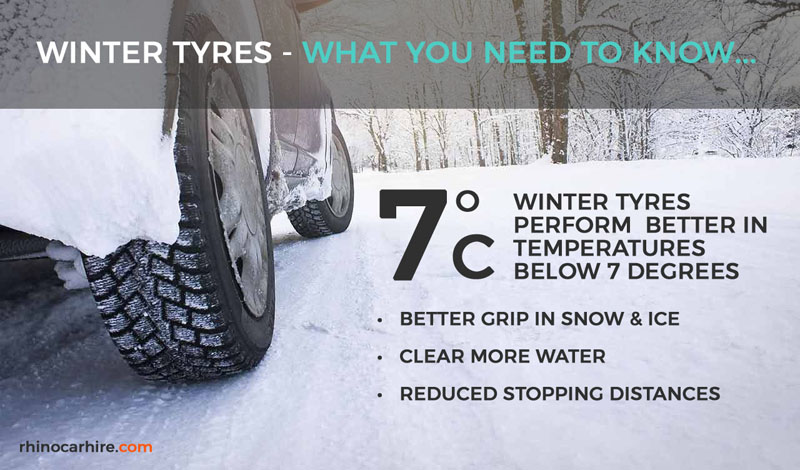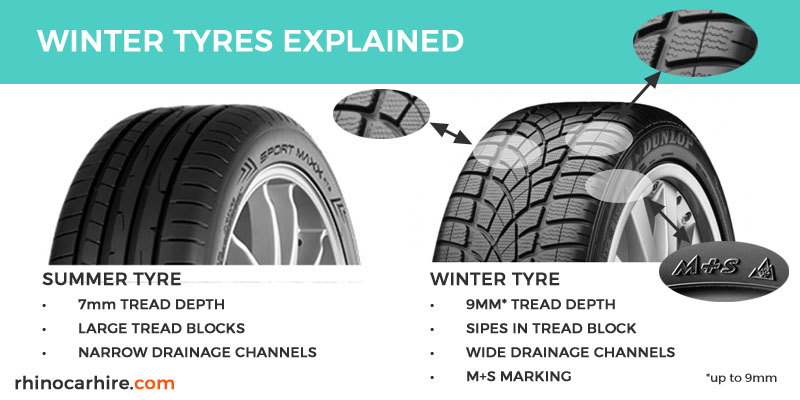
How Are Winter Tyres Different
Are winter tyres really any different to summer tyres or is it just a marketing stunt to get us to buy more tyres. Even if they are better, do you need winter tyres in the UK?
It’s all in the Rubber
The main difference between winter tyres and regular ‘summer tyres’ is the rubber compound used in the construction of the tyre. A summer tyre uses a relatively hard rubber compound that softens to generate more grip as the tyre temperature increases. The ambient temperature, plus the friction between tyre and road (this increases with speed) generates heat in the tyre. Every 1 degree C affects tyre pressure by 0.2 PSI, so a 5 degree change in temperature will increase or decrease the pressure in the tyre by 1 psi. It's important to check tyre pressure / adjust for summer / winter when temperatures change significantly to prolong the life of the tyre and ensure they are operating within their design parameters.
When the temperatures drop however, the rubber does not achieve its optimum design temperature and at this point is generating less grip. A winter tyre uses a much softer rubber compound and has more natural rubber in its composition keeping it softer. A softer rubber (not to be confused with lower tyre pressure) will move around more and stretch to find grip on low friction surfaces.
The Tread Design / Depth
As well a softer rubber compound, the tread pattern itself is designed aid the rubber blocks moving around to generate heat, ‘sipes’ are small cuts in the main tread blocks that allow the main tread to move and provide extra grip in cold / icy conditions. The main tread pattern itself is also designed to remove more water from the surface of the road and prevent aquaplaning. Winter tyres not only perform better in extreme cold conditions, but also in extreme wet conditions. Whilst a summer tyre starts life with 7mm of tread depth, a winter tyre can have as much as 9mm and it is generally recommended that you should change winter tyres when they have less than 3mm rather than the 1.6mm that is legally required. Whilst a winter tyre is legal above 1.6mm of tread, it will be far less effective.

What Are M+S Tyres
This simply means ‘Mud and Snow’ and all winter tyres will carry this symbol on the sidewall of the tyre. Whilst you should be able to differentiate between a winter and summer tyre by the tread pattern, the M+S logo on the sidewall of the tyre will confirm this.
Options for Running Winter Tyres
Many manufacturers are now offering a winter driving service where you can buy a set of winter tyres for use in the winter months only and the dealer will store the set of wheels / tyres from your vehicle whilst not in use. This offers a useful service for many drivers who may not have the storage space, or ability to change the wheels on their car. Whilst a useful service, it does not come cheap and BMW prices start from £700 plus £30 storage fee for a complete set of wheels and tyres for it's most basic model.
Alternatively, you can simply buy a set of winter tyres and have them swapped onto your car at a local tyre garage. This will require you to store and transport the tyres yourself, although this is only likely to be twice a year and costs around £15 per wheel at a local garage (£60 total) As a rule of thumb, you could reasonably run winter tyres from November through until March and summer tyres from April through to October, but this will vary depending on
where you live in the UK.
How Much Do Winter Tyres Cost
Much like regular tyres on your car, winter tyres are available from a range of manufacturers and prices vary. You can expect to pay around 20% more for a comparable winter tyre for your car (size / spec) than a summer tyre, so if a summer tyre for your car from a premium brand costs around £100 per tyre, you can expect to pay around £120 for a winter tyre. We looked at the most popular winter tyre sizes from a major online tyre retailer and compared like for like sizes / spec from premium brands to demonstrate the price comparison between winter and summer tyres.
Size
Summer
Make / Model
Winter
Make / Model
%
185/55/15
£56.68
Pirelli Cinturato All Season
£73.46
Pirelli Cinturato Winter
130%
195/65/15
£50.56
Michelin Energy Saver +
£54.18
Michelin Alpin 5
107%
205/55/16
£50.80
Goodyear EfficientGrip Performance
£68.89
Goodyear UltraGrip 9
136%
215/45/17
£81.66
Pirelli P Zero Nero
£126.38
Pirelli Sottozero £
155%
225/45/18
£118.88
Dunlop Sport Maxx RT2
£133.6
Dunlop Winter Sport 5
112%
*Prices from Blackcircles.com, mail order only - June 2018
You'll find that winter tyres are not available in as many sizes as summer tyres and you may not be able to source a winter tyre in the same size as your summer tyres. It's not uncommon to have smaller wheels in the winter with a deeper tyre profile (it's important to ensure the rolling radius is the same). A deeper sidewall tyre offers more protection from kerbing than a low profile tyre. It's easier to kerb your wheels in winter as you may not be able to see the kerb stones when parking due to lying snow.
How Long Do Winter Tyres Last?
Winter tyres offer more grip in cold and wet conditions due to the softer rubber compound used, anyone that watches Formula 1 will know that a soft rubber compound wears much quicker than a harder compound, particularly in warmer temperatures. If used in the optimum temperature range, a winter tyre will last about the same amount of time (mileage) as a summer tyre, however if used in warmer temperatures, they will wear much quicker, as much as twice as fast. Of course if you swap between summer and winter tyres for the summer / winter months then your summer tyres are not being worn, so the total life of your tyres should not be affected.
What are All Weather Tyres
Some manufacturers make what they call an ‘all weather’ tyre which is a middle ground between a summer and winter tyre which is claimed offer the best of both worlds. In reality, an all weather tyre won’t give the same performance in summer or winter conditions (as with either a summer or winter tyre), however will provide a reasonable level of grip in all weathers. They are generally aimed at wet weather rather than the cold. As the old saying goes, 'Jack of all trades, master of none' is very relevant when it comes to all weather tyres. They'll be adequate in all conditions, but excel in none.
More on Winter Tyres
Comments